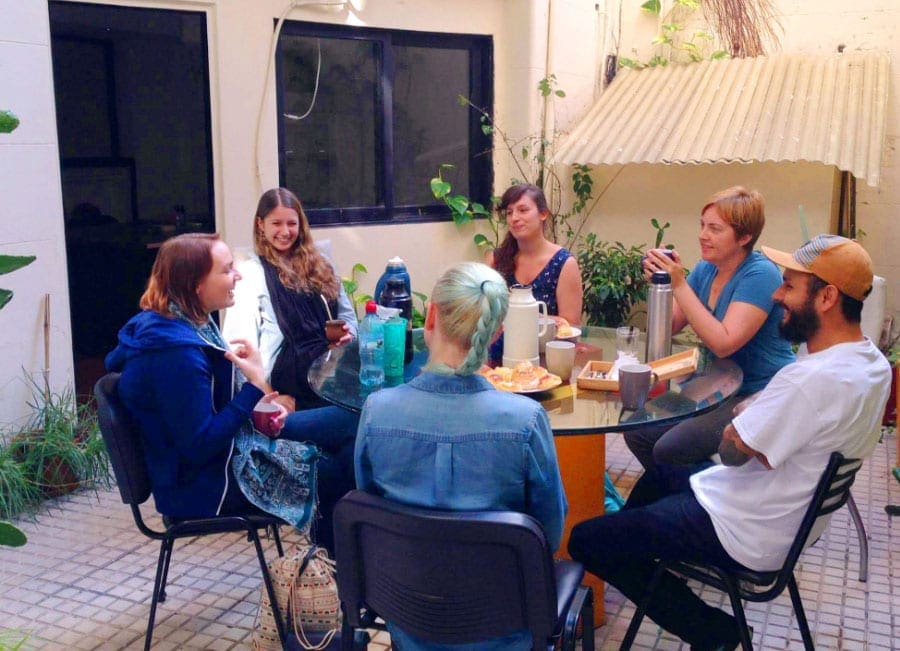Filler words, or palabras de relleno, are commonly used in Spanish conversations to fill pauses and convey hesitation or uncertainty. These colloquial Spanish expressions add flavor and authenticity to your speech, making you sound more natural and fluent. In this guide, we will explore the common Spanish filler words and their meanings, understand the role of filler words in Spanish, and provide tips on how to use them effectively in conversational Spanish phrases.
Key Takeaways:
- Spanish filler words, or palabras de relleno, are used in everyday conversations to fill pauses and convey hesitation or uncertainty.
- Incorporating filler words into your Spanish speech can make you sound more natural and fluent.
- Filler words serve a similar purpose in Spanish as they do in English, adding a casual and conversational tone to your speech.
- Common Spanish filler words include pues, bueno, vale, oye, mira, and es que.
- By practicing using filler words in various contexts, you can enhance your fluency and improve your overall command of the Spanish language.
Understanding the Role of Filler Words in Spanish
Filler words in Spanish serve a crucial function in conversation, enhancing the natural flow and colloquial nature of the language. Similar to filler words in English, they are used to express hesitation, emphasize a point, give the speaker time to think, or add a casual tone to conversation. Incorporating filler words into your Spanish speech can make you sound more fluent and native-like.
Interested in Learning Spanish:
- Start your Spanish Program in Malaga
- Find a Spanish Teacher in Buenos Aires
- Or Take Live Online Spanish Classes
These colloquial expressions are an essential part of everyday Spanish, allowing speakers to convey meaning, connect with the listener, and create a sense of authenticity in their communication. By understanding and incorporating these filler words into your conversations, you can enhance your language skills and engage in more meaningful interactions.
Understanding the Function of Filler Words
Filler words in Spanish play various roles depending on the context. They can serve as transitional phrases, giving the speaker a brief moment to gather their thoughts or formulate a response. Additionally, filler words can be used to express agreement, disagreement, doubt, or uncertainty. They add a casual and conversational tone to speech, making it sound more natural and relaxed.
| Filler Word | Meaning | Usage |
|---|---|---|
| pues | well | Used to fill pauses and introduce a statement or response. |
| bueno | well | Used to express agreement, hesitation, or to start a conversation. |
| vale | okay | Used to indicate understanding, agreement, or as a conversational filler. |
| oye | listen | Used to get someone’s attention or initiate a conversation. |
| mira | look | Used to emphasize a point or draw attention to something. |
| es que | the thing is | Used to provide explanations or justify a statement. |
By familiarizing yourself with these common filler words and their meanings, you can incorporate them into your conversations and sound more like a native Spanish speaker.

Common Spanish Filler Words and Their Meanings
When speaking Spanish, incorporating filler words can greatly enhance your fluency and naturalness in conversation. These casual expressions are commonly used in everyday Spanish and serve various purposes, from expressing agreement to attracting attention. Let’s explore some common Spanish filler words and their meanings:
Pues
Pues is a versatile filler word that can be used to express agreement, hesitation, or uncertainty. It is often translated as “well” in English, but its meaning can vary depending on the context. For example, if someone asks you if you want to go out for dinner and you agree, you can respond with “pues sí” (well, yes).
Bueno
Bueno is another commonly used filler word that translates to “well” or “okay” in English. It can be used to indicate agreement, as well as to buy time to think or transition to a new topic. For instance, you might use “bueno, vamos” (well, let’s go) to show your willingness to do something.
Vale
Vale is a popular filler word that is often used in Spain. It is equivalent to saying “okay” or “alright” in English. It can be used to indicate agreement, approval, or understanding. For example, you might respond with “vale, te veo luego” (okay, see you later) when making plans with someone.
| Filler Word | Meaning |
|---|---|
| Pues | Expresses agreement, hesitation, or uncertainty |
| Bueno | Indicates agreement, buys time, or transitions to a new topic |
| Vale | Expresses agreement, approval, or understanding |
Using Filler Words in Spanish Conversations
Incorporating filler words into your Spanish conversations can greatly enhance your fluency and make you sound more like a native speaker. These words serve various purposes and add a natural flow to your speech. Here are some tips for using filler words effectively in your conversations:
- Fill pauses: Filler words are used to fill pauses in speech, giving you a moment to gather your thoughts and continue the conversation smoothly.
- Express hesitation: Filler words like “pues” and “bueno” can be used to express hesitation or uncertainty, allowing you to think before responding or to indicate that you are considering different options.
- Add emphasis: Filler words can add emphasis to certain words or phrases, helping you convey your thoughts more effectively and make your speech more engaging.
- Create a conversational tone: Incorporating filler words in your speech can create a more casual and conversational tone, making your conversations feel more natural and relaxed.
When using filler words, it’s important to use them appropriately and in moderation. Overusing them can make your speech sound unnatural and may distract from the main message you are trying to convey. Pay attention to how native speakers use filler words in different contexts and practice incorporating them into your own conversations.
Examples of Filler Words in Context:
| Filler Word | Meaning/Usage |
|---|---|
| Pues | Well, so; used to express hesitation or to introduce a new thought |
| Bueno | Okay, well; used to fill pauses and indicate agreement or understanding |
| Vale | Okay, all right; used to indicate agreement or acceptance |
| Oye | Listen; used to get someone’s attention or as a filler word in casual conversation |
| Mira | Look; used to get someone’s attention or to introduce a new thought |
| Es que | The thing is; used to provide an explanation or justification |
By incorporating filler words into your Spanish conversations, you can improve your overall language skills and connect more effectively with native speakers. Remember to use them naturally and appropriately, and practice incorporating them into your everyday speech. With time and practice, you’ll become more comfortable and confident in using filler words to enhance your fluency and sound more like a native speaker.

Enhancing Fluency with Spanish Filler Words
Filler words play a crucial role in enhancing fluency in Spanish conversations. These words serve as linguistic tools that give speakers time to gather their thoughts, make their speech sound more natural, and create a rhythm in conversation. Incorporating filler words into your Spanish speech can help you sound more like a native speaker and improve your overall communication skills.
Start your Spanish Classes in Toronto Today
When using filler words in Spanish, it is important to select the appropriate word for the context. For example, “pues” can be used to express agreement or hesitation, while “bueno” is commonly used to buy time or set the stage for an explanation. By understanding the nuances of different filler words, you can use them effectively and appropriately in conversation.
Practicing the use of filler words in different situations is key to enhancing your fluency. Listen to native Spanish speakers and pay attention to how they incorporate filler words into their speech. Try using filler words in your own conversations and focus on integrating them naturally. With time and practice, you will become more comfortable and confident in using filler words to enhance your fluency and sound more like a native Spanish speaker.

Additional Resources
- Spanish Filler Words: A Comprehensive Guide – Learn more about the different types of filler words and their meanings in Spanish.
- Colloquial Spanish Expressions: Adding Flavor to Your Conversations – Explore other colloquial expressions that can enhance your Spanish conversations.
- Improving Your Spanish Fluency: Tips and Techniques – Discover more strategies for improving your overall fluency in Spanish.
| Filler Word | Meaning | Usage |
|---|---|---|
| pues | well, so | Express agreement, hesitation, or introduce an explanation. |
| bueno | well, um | Buy time, introduce a topic, or prepare for an explanation. |
| vale | okay | Express agreement or confirmation. |
| oye | listen | Attract attention or initiate a conversation. |
| mira | look | Attract attention or emphasize a point. |
| es que | the thing is | Provide an explanation or reason. |
Tips for Using Filler Words Effectively
When incorporating filler words into your Spanish conversations, it’s important to use them effectively to maintain a natural flow and enhance your communication. Here are some tips to help you use filler words appropriately:
- Listen to native speakers: Pay attention to how native Spanish speakers use filler words in different contexts. This will help you understand the appropriate usage and improve your fluency.
- Observe the conversation: Use filler words when you need a moment to gather your thoughts or emphasize a point. They can add clarity and rhythm to your speech, making it more engaging for your conversation partner.
- Use filler words sparingly: While filler words are essential for conversational Spanish, it’s important not to overuse them. Incorporate them naturally and purposefully to avoid sounding hesitant or unsure.
- Practice with native speakers: Engage in conversations with native Spanish speakers to practice using filler words. Their feedback can help you refine your usage and improve your overall language skills.
By following these tips, you can effectively integrate filler words into your Spanish conversations and enhance your fluency and naturalness. Remember that practice makes perfect, so keep incorporating filler words into your speech and strive for continuous improvement.

Example Table: Contrasting Filler Words Usage
| Filler Word | Meaning | Appropriate Usage | Common Mistakes |
|---|---|---|---|
| pues | well | Used to express hesitation or buy time to think | Overusing it and using it as a filler without purpose |
| bueno | well | Used to indicate agreement or introduce a new topic | Using it excessively or inappropriately |
| vale | okay | Used to show comprehension or agreement | Mispronouncing it or using it too frequently |
This table showcases the usage, meaning, appropriate usage, and common mistakes associated with different filler words in Spanish. It can serve as a guide to help you use these words effectively in your conversations.
Common Mistakes to Avoid with Spanish Filler Words
While using filler words can enhance your Spanish conversations, it’s important to avoid common mistakes that can make your speech sound unnatural. Here are some mistakes to avoid:
- Overusing filler words: Using filler words excessively can make your speech sound repetitive and less fluent. Instead, focus on using them naturally and sparingly to enhance your conversation.
- Using inappropriate filler words: Each filler word has its own context and meaning. Using them in the wrong situation can lead to confusion or misunderstanding. Make sure to understand the proper usage of each filler word.
- Using filler words for the sake of using them: Adding filler words without a purpose can make your speech sound forced. Use filler words when they add meaning or emphasis to your conversation, rather than just as a filler for pauses.
- Not paying attention to pronunciation: Pronunciation is key when using filler words. Make sure to practice the correct pronunciation of each word to ensure clarity and avoid misunderstandings.
By being mindful of these common mistakes, you can use filler words effectively and sound more natural in your Spanish conversations.

| Common Mistakes to Avoid with Spanish Filler Words |
|---|
| Overusing filler words |
| Using inappropriate filler words |
| Using filler words for the sake of using them |
| Not paying attention to pronunciation |
Incorporating Filler Words in Everyday Spanish Conversations
When engaging in everyday conversations in Spanish, incorporating filler words can add authenticity and enhance your fluency. These colloquial expressions are commonly used by native speakers and can help you sound more natural in your speech. By practicing the usage of filler words and paying attention to their appropriate context, you can effectively integrate them into your conversations and connect more effectively with Spanish speakers.
Filler words such as “pues” (well), “bueno” (well), and “vale” (okay) are frequently used to indicate agreement, express hesitation, or give the speaker time to gather their thoughts. These words act as conversational placeholders, allowing you to maintain momentum in the conversation and prevent uncomfortable silences. Incorporating filler words into your speech also helps you establish a casual, friendly tone in your interactions, fostering a sense of connection with your conversation partner.
When using filler words, it’s important to pay attention to the appropriate context and usage. Observing native Spanish speakers and listening to their conversations can provide valuable insight into the natural flow and application of filler words. By actively incorporating filler words into your own conversations and seeking feedback from native speakers, you can refine your usage and develop fluency in incorporating these expressions seamlessly into your speech.

Example Table: Common Filler Words and Their Meanings
| Filler Word | Meaning |
|---|---|
| pues | well |
| bueno | well |
| vale | okay |
By incorporating filler words into your everyday Spanish conversations and practicing their appropriate usage, you can enhance your fluency and sound more like a native speaker. Remember to use these expressions naturally and in moderation, maintaining a balanced and authentic conversational style. With time and practice, you will become more comfortable and confident in incorporating filler words to enrich your Spanish communication skills.
Mastering Spanish Filler Words for Fluent Conversations
Fluent conversations in Spanish require more than just grammar and vocabulary. Incorporating filler words allows you to speak with greater ease and fluidity, resembling the natural speech patterns of native speakers. By mastering Spanish filler words, you can enhance your conversational skills and engage in more authentic and meaningful interactions in the language.
Filler words play a crucial role in enhancing fluency in Spanish. They give you time to gather your thoughts, make your speech sound more natural, and create a sense of rhythm in conversation. Practice using filler words in different situations to develop your fluency and improve your overall command of the Spanish language.
When using filler words in Spanish, it’s important to be mindful of their appropriate usage and context. Here are some tips to help you use filler words effectively:
- Listen to native speakers: Pay attention to how native speakers use filler words in conversations. This will help you understand the natural flow and rhythm of the language.
- Practice in context: Use filler words in appropriate situations to convey the desired meaning. For example, use “pues” to express hesitation or “bueno” to indicate agreement.
- Don’t overuse filler words: While filler words add fluency and naturalness to your speech, using them excessively can make your conversation sound forced or unnatural. Use them sparingly and strategically.
- Observe non-verbal cues: Pay attention to non-verbal cues from your conversation partner to gauge their understanding and engagement. Adjust your usage of filler words accordingly.
By following these tips and incorporating filler words into your Spanish conversations, you can improve your fluency, sound more natural, and connect more effectively with native speakers. Remember, mastering filler words is a key aspect of becoming a confident and fluent Spanish speaker.

Benefits of Using Spanish Filler Words in Conversations
Incorporating filler words into your Spanish conversations offers several benefits. These small yet impactful words can help you sound more natural and fluent in your speech, allowing you to blend in seamlessly with native Spanish speakers. By using filler words appropriately, you can enhance your overall communication skills and convey your thoughts and emotions more effectively.
One of the primary advantages of using filler words in conversations is that they improve your fluency. These words give you time to gather your thoughts, helping you avoid long pauses or hesitations. By using filler words strategically, you can maintain a steady flow of speech and appear more confident in your language abilities.
Filler words also play a crucial role in conveying emotions and nuances in your conversations. They can be used to express agreement, doubt, surprise, or even frustration. By incorporating these words into your speech, you can add depth and authenticity to your communication, making your conversations more engaging and meaningful.
| Benefits of Using Spanish Filler Words in Conversations |
|---|
| Improved fluency: Filler words help you maintain a steady flow of speech, reducing hesitations and pauses. |
| Conveying emotions and nuances: Filler words allow you to express agreement, doubt, surprise, or frustration in a more nuanced way. |
| Enhanced connection: Using filler words creates a sense of familiarity and connection with native Spanish speakers. |
| Natural and fluent speech: Incorporating filler words makes your speech sound more natural and fluent, resembling native speakers. |
Furthermore, using filler words can help you establish a connection with your conversation partner. Native Spanish speakers often use these words in their everyday conversations, so by using them yourself, you create a sense of familiarity and camaraderie. This can lead to more meaningful and enjoyable interactions, as it shows your effort to adapt to the language and culture.
In summary, incorporating filler words into your Spanish conversations can have significant benefits. From improving your fluency and conveying emotions to enhancing your connection with native speakers, these words add depth and authenticity to your speech. By practicing their usage and paying attention to context, you can become a more confident and effective communicator in the Spanish language.

Conclusion
Incorporating filler words into your Spanish conversations is an effective way to sound more fluent and natural. By understanding the nuances of different filler words and practicing their usage in conversation, you can improve your overall language skills and connect more effectively with native speakers.
Filler words, or palabras de relleno, play a significant role in colloquial Spanish expressions and conversational Spanish phrases. They help convey hesitation, provide explanations, request attention, and express agreement or uncertainty. By incorporating these words into your speech, you can sound more authentic and create a connection with your conversation partner.
However, it’s essential to use filler words appropriately and avoid overusing them. Balancing their usage with other aspects of speech will help maintain a natural conversational style. Practice using filler words in different situations and contexts to develop fluency and enhance your overall command of the Spanish language.
Remember, mastering Spanish filler words takes time and practice. By incorporating them into your everyday conversations, you can enhance your fluency, improve your communication skills, and engage in more meaningful interactions with native Spanish speakers.
FAQ
What are filler words in Spanish?
Filler words, or palabras de relleno, are used in Spanish to fill pauses and convey hesitation or uncertainty.
What are some common examples of Spanish filler words?
Some common examples of Spanish filler words include pues, bueno, vale, oye, mira, and es que.
Why are filler words used in Spanish conversations?
Filler words are used in everyday conversations to buy time, express agreement or hesitation, request attention, or provide explanations.
How can incorporating filler words improve Spanish fluency?
By incorporating filler words into your Spanish speech, you can sound more natural and fluent in conversation.
What are some tips for using filler words effectively in Spanish?
It’s important to understand the nuances of each filler word and use them appropriately in conversation.
What are some common mistakes to avoid when using filler words in Spanish?
Common mistakes to avoid include overusing filler words or using them inappropriately.
How can I incorporate filler words into my everyday Spanish conversations?
Focus on listening to native speakers and practicing using filler words in various contexts.
What are the benefits of using filler words in Spanish conversations?
Using filler words can help you sound more natural, improve fluency, convey emotions, and establish a connection with your conversation partner.

